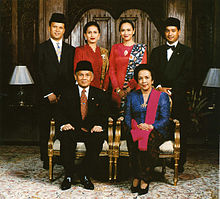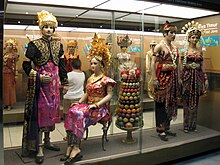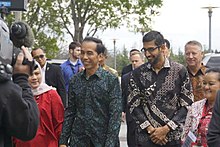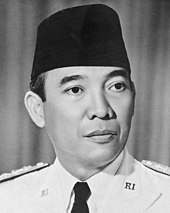National costume of Indonesia
[2] Since Java has been the political and population center of Indonesia, folk attire from the island has become elevated into national status.
Batik cloth were wrapped around the hips with multiple folds in front called wiron, while the upper torso wear kebaya fitted dress.
The kebaya is the national attire of women from Indonesia, although it is more accurately endemic to the Javanese, Sundanese and Balinese peoples.
[2] It is sometimes made from sheer material such as silk, thin cotton or semi-transparent nylon or polyester, adorned with brocade or floral pattern embroidery.
Kebaya is usually worn with a sarong or batik kain panjang, or other traditional woven garment such as ikat, songket with a colorful motif.
The earliest form of kebaya originates in the court of the Javanese Majapahit Kingdom as a means to blend the existing female Kemban, torso wrap of the aristocratic women to be more modest and acceptable to the newly adopted Islam religion.
In Indonesia, the black velvet peci has become the national headdress with secular nationalist connotations made popular by Sukarno.
Senior citizen Muslim men across Indonesia — usually in Jakarta who identify themselves as native Betawi people, also use this peci on an everyday basis.
Some examples of Indonesian regional attires (baju adat) are: Stamped batik, the design of which takes months to create; double weave ikat from the islands of Nusa Tenggara, silk Bugis sarong from Sulawesi, gold-painted Balinese prada fabric; shimmering kain songket from Palembang utilizing silver and gold metallic threads weft in woven cotton or silk ikat; and tapis weavings from Lampung.
Primarily formed on back looms, weeks or months are spent creating intricate designs for everyday use or ceremonial wear.
Special textiles are worn or exchanged in life cycle or rights of passage ceremonies celebrating birth, circumcision, puberty, marriage, childbearing and death.
Written records dating to the fourteenth century document the importance of textiles in the social and religious lives of Indonesians.
Tight fitting women's kebaya and tailored batik shirt for men is the example of traditional clothing that today transcends ethnic boundaries in Indonesia and has become a national attire.







